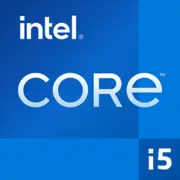Intel Core i5-1240U

Intel Core i5-1240U: A Balance of Performance and Battery Life for Modern Ultrabooks
(Relevant as of March 2025)
Introduction
CPUs for thin and light laptops always involve a compromise between power, energy consumption, and cost. The Intel Core i5-1240U, released in 2022, remains a popular choice for budget and mid-range ultrabooks. In this article, we will explore who this chip is suitable for, how it performs in real tasks, and what to consider when purchasing a device based on it.
Architecture and Process Technology: Hybrid Approach and Optimization
Alder Lake Hybrid Cores
The Core i5-1240U is built on the Alder Lake architecture with a hybrid core structure:
- 2 Performance-cores (P-cores) with Hyper-Threading support (4 threads).
- 8 Efficient-cores (E-cores) without Hyper-Threading (8 threads).
Total: 10 cores and 12 threads. The P-cores handle "heavy" tasks (like rendering), while the E-cores manage background processes (updates, music streaming).
Clock Frequencies:
- Base: 1.1 GHz (P-cores), 0.8 GHz (E-cores).
- Turbo Boost: up to 4.4 GHz for P-cores, up to 3.3 GHz for E-cores.
Cache: 12 MB L3 — sufficient for smooth operation in office applications and browsing with multiple tabs open.
Integrated Graphics Intel Iris Xe
The Iris Xe iGPU (96 EU) supports:
- 4K@60 Hz via HDMI 2.0 or DisplayPort.
- Hardware decoding of AV1 and VP9 for 4K streaming.
- Gaming at low settings: e.g., CS:2 (40-50 FPS), GTA V (30-45 FPS).
Intel 7 Process (formerly 10 nm Enhanced SuperFin):
This allows for reduced energy consumption without sacrificing performance. In comparison, AMD's competitors (Ryzen 5 7530U) use TSMC's 6 nm.
Power Consumption and TDP: 9W for Thin Chassis
The nominal TDP of the processor is 9W, but in turbo mode, consumption can reach 29W. This is important to consider:
- In ultrabooks (e.g., Lenovo Yoga 7i), the cooling system is designed for 15-20W, so under prolonged load, throttling is possible.
- In budget laptops (Acer Swift 3), cooling is weaker — the chip tends to operate at base frequencies more often.
Tip: When choosing a device, check whether it is equipped with a fan or uses passive cooling. The latter option is suitable only for working with documents.
Performance: From Word Processing to Casual Gaming
Office Work and Multitasking
- Google Chrome with 20+ tabs + Zoom + Excel: The processor handles this without noticeable slowdowns, thanks to the E-cores that help offload the P-cores.
- Running a virtual machine (e.g., Ubuntu): There may be delays when working simultaneously in Photoshop.
Multimedia
- Adobe Photoshop (2025): Processing RAW files takes 15-20% longer than with the Core i7-1260P.
- Premiere Pro (1080p video): Rendering using Intel Quick Sync is 30% faster compared to chips without AV1 hardware decoding.
Gaming
Iris Xe is not a substitute for a discrete GPU, but it suffices for less demanding projects:
- Dota 2: 50-60 FPS at low settings (720p).
- Fortnite: 30-40 FPS (720p, Performance mode).
Important: In gaming with turbo mode, the processor heats up to 85-90°C, which may lead to throttling after 10-15 minutes.
Turbo Boost: How Long It Sustains Peak Frequency
- Short loads (up to 30 seconds): P-cores reliably operate at 4.2-4.4 GHz.
- Long tasks (video conversion): Frequencies drop to 2.8-3.0 GHz (P-cores) and 2.4 GHz (E-cores).
Use Cases: Who Needs the i5-1240U in 2025?
- Students: Working with texts, online courses, light presentation editing.
- Office Workers: Teams, Excel, corporate CRM systems.
- Travelers: Long battery life, compactness.
- Casual Gamers: Indie games and older titles.
Not Suitable for:
- 3D modeling in Blender or 4K video editing.
- Streaming games at high settings.
Battery Life: Up to 10 Hours Under Ideal Conditions
- Scenario "reading + browsing": 8-10 hours (with a 60Wh battery).
- Watching Netflix: 5-6 hours.
- Power-saving technologies:
- Intel Dynamic Tuning: Automatically reduces frequencies during idle.
- Chipset Deep Sleep: Turns off unused components.
Example: The ASUS Zenbook 14 (2025) with i5-1240U and a 70Wh battery operates for up to 12 hours in power-saving mode.
Comparison with Competitors
AMD Ryzen 5 7540U (Zen 4, 4nm)
- Pros: Better in multithreaded tasks (8 Zen 4 cores), supports DDR5-5600.
- Cons: Radeon 740M graphics are weaker than Iris Xe in gaming.
- Price: Laptops with Ryzen 5 7540U start at $750 (compared to $650 for models with i5-1240U).
Apple M2
- Pros: 30% better battery life, operates cool.
- Cons: Limited compatibility with Windows software.
- Price: MacBook Air M2 — starts at $999.
Pros and Cons of the Core i5-1240U
Pros:
- Optimized for thin laptops.
- Support for Thunderbolt 4 and Wi-Fi 6E.
- Good integration with Windows 11.
Cons:
- Limited future-proofing (2027+).
- Noisy fans under load.
Recommendations for Choosing a Laptop
1. Type of Device:
- Ultrabook: Dell XPS 13 (2025), weight up to 1.2 kg.
- Budget Laptop: HP Pavilion Aero 13, starting price of $650.
2. What to Look for:
- Display: IPS panel with 300 nits is ideal for working in bright conditions.
- Memory: 16 GB LPDDR5 — minimum for Windows 11 and multitasking.
- Storage: 512 GB SSD (PCIe 4.0).
Final Conclusion
The Intel Core i5-1240U is a solid choice for those seeking an affordable (up to $700) laptop with long battery life and sufficient performance for everyday tasks. It falls short compared to the new Ryzen 8000U and Apple M3 in multithreaded scenarios but wins on accessibility and compatibility. If you need a compact device for study, work, and occasional gaming, this processor is worth considering.
Basic
CPU Specifications
Memory Specifications
GPU Specifications
Miscellaneous
Benchmarks
Compared to Other CPU
Share in social media
Or Link To Us
<a href="https://cputronic.com/cpu/intel-core-i5-1240u" target="_blank">Intel Core i5-1240U</a>